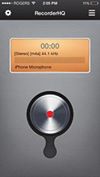Deciding on a place and time to record the interview was the easiest part of this process. Jena and I agreed to meet a week and a half before the due date, to ensure we both had ample time to edit and complete our podcast. However, on the day of, we decided to postpone the interview because neither one of us were prepared with questions. We both felt it was necessary to have an idea of what we were going to ask one another, therefore we took an extra two days to create a list of questions.
We chose to conduct the interview in one of the study rooms in the Institutional Building. Since the room was small and enclosed, it eliminated any echoing or fuzz from being recorded in the background of the interview. I downloaded a number of recording applications on my iPhone including, GarageBand, SmartRecord and QuickVoice Recorder; however I chose to use RecorderHQ as well as Audacity as a backup.
The interview itself was not what I expected. I not only thought I was going to follow the exact order of my questions, but also that I had an idea of how Jena would answer them. However, during the interview Jena began to talk about her personal struggle with mental health. I followed her lead and the interview soon became more like a conversation.
I recorded my interview with Jena 6 times to ensure that I had enough material to play with while editing. Having many recordings of the interview, each lasting between 8 to 11 minutes, was extremely difficult to work with. Although each recording had similar answers, I drove myself crazy, repeatedly listening to all 6 and trying to pick out Jena’s best answers. In order to shorten the interview to 3 minutes, I also cut out speech ticks such as “uh” and “um,” as well as pauses and information that the interview could do without. Audacity was a great editing tool – despite how much I edited out, the audio sounded like one seamless piece.
I found transcribing the interview to be simple yet tedious. First, I played the entire interview, typing as much of what I heard. I then played the interview three more times, filling in what I missed. After completing the transcription, I played the interview one last time to add in the timings. I tried to use http://otranscribe.com, as suggested by Joan but my audio was not uploading onto the website.
Overall, completing my first podcast was a great experience. I look forward to starting on my podcast series.

